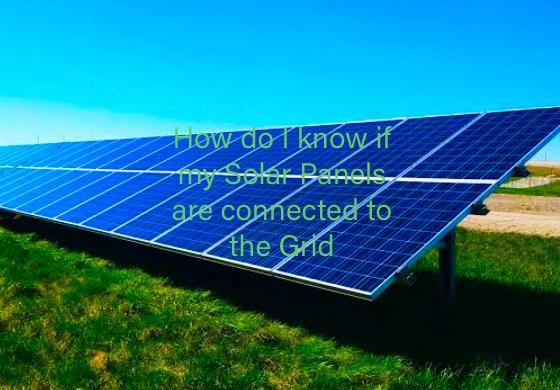If you’re using a solar system for energy generation, it makes sense to know whether it is connected to the grid or not. If it is not linked, then you will need to do that as soon as possible to enable you to enjoy the benefits that come with tying your solar panels to the grid.
Due to the numerous benefits that come with linking a solar system to the grid, we’re going to answer this pressing question: how do I know if my solar panels are connected to the grid? At the end of this guide, you’ll know if your system is grid-tied or not. Stay tuned, as the discussion is going to be smooth, educational, and interactive.
There are a couple of ways that you can use to check if your solar panels are grid-linked, starting with checking your inverter display unit, reviewing your electricity bill, and using monitoring software. With these methods, you will be able to differentiate between grid-tied solar systems and non-grid connected solar panels.
What is a Grid-Connected solar system?

A grid-connected solar system, also known as an on-grid or grid-tied system, is a solar power setup that is linked to the public electricity grid.
This type of system allows user to draw electricity from the grid when their solar panels are not generating enough power, such as on cloudy days or during the night.
On the other hand, if solar panels generate excess electricity, it is going to be fed back into the grid, which will in turn become a credit on your electricity bill through the net metering process. The grid-tied system is beneficial to electricity consumers.
Benefits of a Grid-Connected Solar System
The benefits of grid-tied solar system to electricity consumers are:
- The system is cost-effective, reducing energy costs
- A grid-connected solar system ensures a continuous power supply
- This system also reduces maintenance costs.
How to know if your solar panels are connected to the grid
There are a number of methods that you can use to check if your solar panels are connected to the grid. The methods are:
1. Check Your Inverter
One of the simplest methods that you can use to check if your solar panels are connected to the grid is by checking your inverter.
The solar system inverter is the device that converts solar panel direct current (DC) into alternate current (AC) that is used in the home. So, to check if your solar system is grid-tied, you’ll need to go to your inverter and check its indicator light. Some of these modern inverters normally provide detailed information about the system’s status. Check the light to see if there is any indication that the system is grid-connected.
Alternarively, you can also check your inverter screen to know if it displays information like “Grid-Tie” or “Grid-Connected,” since most of them show real-time data usage. If it displays “Grid-Tie” or “Grid-Connected,” it means that your solar system is grid-tied.
2. Monitor Your Electricity Meter
Another method that you can use to check if your system is tied to the grid is by closely monitoring your prepaid electricity meter.
If you are using analog meters, closely observe the direction in which the meter spins. If it spins backward during periods of high solar generation, like during high sun intensity, then it means that the meter is feeding excess electricity back into the grid, which means that the system is connected to the grid.
Meanwhile, if you’re using smart meters, kindly use your smart meter’s app or online portal and check for entries that are related to solar generation grid export. If there is information on the grid, then it means that the system is linked to the grid.
3. Review Your Electricity Bill
By reviewing your electricity bill, you can also check whether your solar system is grid-tied or not. Carefully examine your bill information to see if there is any place where they mention solar credits or net metering. If there is any mention of such, then it means that your solar panels are feeding excess electricity back into the grid, which is a confirmation that the system is grid-connected.
4. Inspect the Solar System’s Wiring and Components
Your system’s wiring can also help you determine whether your solar system is grid-tied or not. What you should do is verify your inverter grid-tei model since off-grid inverters don’t have girc linkage design.
You can also do that by carefully examining your AC disconnect switch. What you should do is check the AC disconnect switch, which permits manual disconnection from the grid. If the switch is properly wired and in the correct position, then it means that the system is grid-tied.
5. Use Monitoring Software
The last method on our list that you can use to check if your system is connected to the grid or not is through the use of monitoring software.
Since most modern solar power systems now come with monitoring software that gives detailed information about overall system performance and grid connection status,. You can check the monitoring software via your computer or smartphone and look for grid connection and power export-related data. If there is such information, then it means that your system is fully linked to the grid.